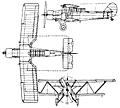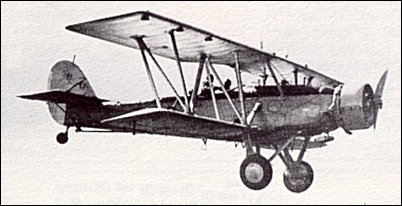|
| The Shark was a carrier-borne torpedo biplane with a buoyant metal-skinned fuselage and a 521.5kW Armstrong Siddeley Tiger IV two-row radial engine. Production for the Fleet Air Arm was undertaken between 1934 and 1937, with 238 Shark I, II and Ill (Pegasus radial engines) being built, many as seaplanes. Accommodation was provided for a crew of two and armament comprised one 680kg torpedo or equivalent bomb load, plus one forward-firing Vickers and one rear-mounted Vickers or Lewis machine-gun. Deck take-offs and landings were aided by the large camber-changing flaps fitted to the aircraft. Sharks served with Nos 820 and 821 Squadrons on board HMS Courageous, No 822 Squadron on board HMS Furious and No 705 (Catapult) Flight on the battleships HMS Repulse and Warspite. The type was also used at Air Gunnery Schools in the UK and Trinidad.
Six Sharks were also delivered to the Portuguese Navy in March 1936 and were based at Bom Succeso on the River Tagus, near Lisbon, where they operated for several years. Four aircraft were built for the Royal Canadian Air Force and 17 Ills were built under licence by Boeing Aircraft of Canada during 1939-40, mainly for the RCAF.
 | A three-view drawing (800 x 718) |
| MODEL | B-6 "Shark" |
| CREW | 2-3 |
| ENGINE | 1 x Armstrong Siddeley "Tiger" VI, 567kW |
| WEIGHTS |
| Take-off weight | 3650 kg | 8047 lb |
| Empty weight | 1830 kg | 4034 lb |
| DIMENSIONS |
| Wingspan | 14.02 m | 46 ft 0 in |
| Length | 10.74 m | 35 ft 3 in |
| Height | 3.68 m | 12 ft 1 in |
| Wing area | 45.43 m2 | 489.00 sq ft |
| PERFORMANCE |
| Max. speed | 241 km/h | 150 mph |
| Cruise speed | 190 km/h | 118 mph |
| Ceiling | 4875 m | 16000 ft |
| Range | 1000 km | 621 miles |
| ARMAMENT | 2 x 7.7mm machine-guns, 680-kg torpedo or 900kg of bombs |
| Christian Hodges, e-mail, 21.02.2025 01:13 Hi Mate,
We are able to help with pay per lead on Google, please visit my website and connect to my whats app and I can discuss about the leads we have in your area. reply | | Barry, 04.09.2012 12:05 No surprise there then when it comes to the Admiralty's choice of aeroplane. After all would this be the same Admiralty that chose such wonderful machines as the Skua, the Roc and the Barracuda? And the list goes on! reply | | Klaatu83, e-mail, 11.12.2011 17:03 In many respects the Shark was a more modern airplane than the more famous Fairey Swordfish. It had an aluminum monocoque fuselage with internal watertight compartments, and an unusual arrangement of super-strong warren girder struts supporting the folding wings. It also seems to have outperformed the legendary Swordfish in several respects. Yet, the Admiralty preferred the seemingly less-advanced Swordfish. reply |
|
Do you have any comments?
|
| 
COMPANY
PROFILE
All the World's Rotorcraft
|







